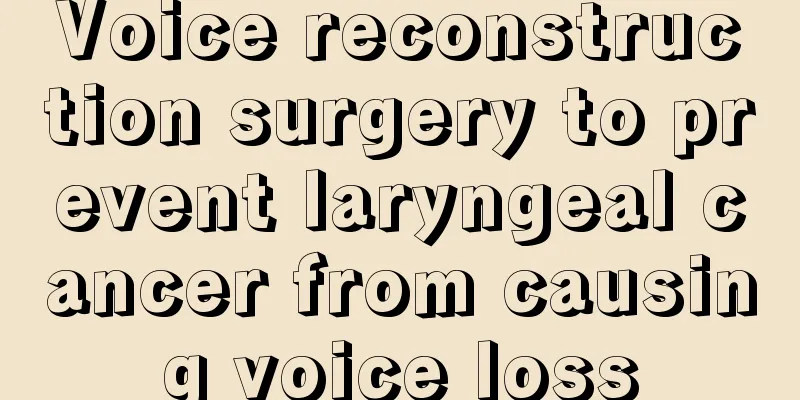Voice reconstruction surgery to prevent laryngeal cancer from causing voice loss

|
59-year-old Mr. Guo has been living alone. His wife passed away early and he has no children. He spends his life farming. Mr. Guo has been smoking for more than 30 years. He thinks smoking is a great pleasure and never thinks of cancer and smoking together. Three months ago, Mr. Guo had hoarseness for several days and even coughed up bloody phlegm. The old man rushed to the hospital. Laryngeal cancer surgery may not save voice After examination, Mr. Guo was diagnosed with advanced squamous cell laryngeal cancer. The tumor had grown all over the right vocal cord in the glottis area, reaching down to the trachea under the glottis, and invading the arytenoid cartilage posteriorly. In order to reduce the chance of recurrence, the doctor planned to perform a total laryngectomy. However, total laryngectomy would cause the patient, Mr. Guo, to lose his ability to speak, and Mr. Guo had no children to take care of him. How could such a helpless and lonely old man face a "speechless" life in the future? Pronunciation reconstruction technology saves Mr. Guo’s “right to speak” In order to enable Mr. Guo to regain the ability to speak and improve his ability to take care of himself, the doctor proposed a treatment plan of "total laryngectomy, anterior cervical skin tracheostomy, and vocal tract reconstruction." First, the laryngeal body and the first tracheal cartilage ring that were severely invaded by the tumor were completely removed, and the surrounding normal blood vessels, nerves, muscles, and mucosa were preserved as much as possible. Then a mucosal flap was cut from the esophagus, and the vocal tract was reconstructed between the patient's trachea and esophagus. Finally, the patient's tracheal opening was sutured to the skin opening in the front of the neck to complete the anterior cervical tracheostomy. After 5 hours of hard work, the operation was successfully completed. After the operation, Mr. Guo still needed a period of recuperation. Half a month later, the dilator tube was removed. Mr. Guo blocked the opening of the trachea in front of his neck with his fingers and exhaled forcefully. The air flowed from the lungs through the trachea, vocal tubes, and esophagus into the pharyngeal cavity. The pharyngeal mucosa vibrated and he made an "ah" sound. Mr. Guo resumes his “audio” life When he heard his own voice, Mr. Guo was very excited and his eyes were filled with tears. After a period of adaptation and practice, Mr. Guo could speak simple words and sentences, and his words were loud and clear. The doctor was surprised and happy to see Mr. Guo casually greet others in the ward. |
<<: Characteristics of TCM in treating middle and late stage laryngeal cancer
>>: How to confirm the diagnosis of liver cancer
Recommend
What to eat to prevent cervical cancer
We all know that cervical cancer is preventable. ...
Diet can prevent prostate cancer. Which foods can prevent prostate cancer?
The prostate organ of male friends is particularl...
What situations can cause colon cancer? These 5 things will increase the risk of colon cancer
I believe everyone knows that many diseases are d...
How to do ear bath
Many people may not know much about ear bathing. ...
Ascaris ileus
Ascaris ileus is intestinal blockage caused by th...
How can lung cancer patients determine whether metastasis has occurred? You can determine it from the following aspects
Lung cancer is a disease that is easy to metastas...
Cochlear implant rehabilitation training is carried out in stages
After wearing a cochlear implant, you also need r...
Harms of Jinhua Black Tea
In modern life, people pay more and more attentio...
Radical cure of early cancer
Diseases such as cancer are among the most seriou...
Can foot soaking lower blood pressure?
We often use the practice of foot soaking in wint...
Can I lose weight by skipping dinner
Many people do not eat at night in order to lose ...
Is microdermabrasion effective for scar removal
If there are scars on the body, it will indeed ha...
Why does the lump above the incision hurt after thyroid cancer surgery?
Thyroid cancer patients may experience a painful ...
Head scraping technique
Head scraping is a traditional Chinese medicine m...
Will mid- to late-stage gastric cancer cause ascites?
The cause of ascites in the late stage of gastric...









